

Light machine gun Fm/Kjellman
Picture from Carl Gustafs Stads Gun Factory Weapon Museum.
The Light Machine Guns of Sweden.
Text and pictures by O. Janson
Updated 2020-04-28
|
The light machinegun by Rudolf Kjellman. |
 |
 |
|
Light machine gun Fm/Kjellman Picture from Carl Gustafs Stads Gun Factory Weapon Museum. |
|
A light machinegun, Fm/Kjellman, was tested 1914 in Sweden which was cooled by water. The constructor was Rudolf Kjellman. He got the idea from a Swedish officer called Friberg who made the design around 1890. The calibre was the standard Swedish 6.5 x 55 mm for the m/1894 cartridge. Significant for the construction was that one of the locking lugs was on top of the breech bolt and the other on the bottom side. The famous German MG 42 used a similar system. The arm was very reliable but to expensive to produce. The production was limited to only 10 weapons! |
Light machinegun by Madsen m/1914. |
|
1914 the Swedish army bought a number of the Madsen machinegun. The Danish constructor had made the weapon for 8 mm but this was changed for the Swedish delivery to the standard Swedish cartridge at that time m/1894 6.5x55 mm. |
|
|
|
Light Machinegun by Madsen Danish M1910 and Swedish m/1914 Picture from Carl Gustafs Stads Gun Factory Weapon Museum. |
|
The BAR-family in Sweden
|
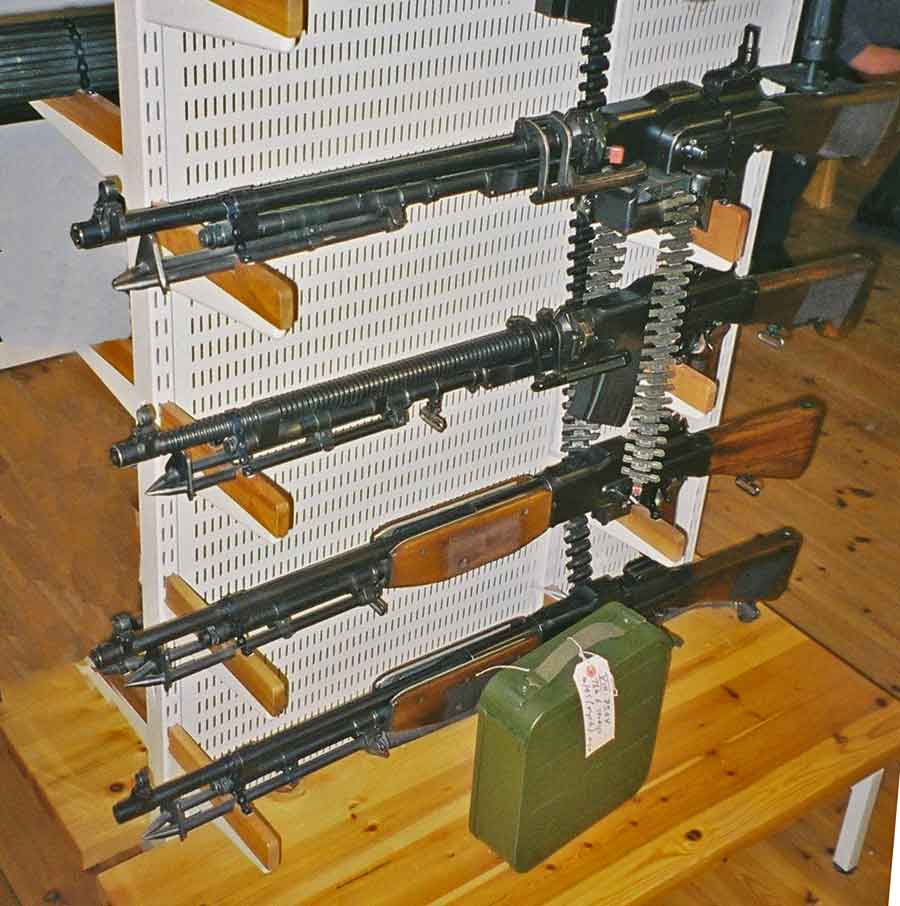 |
|
The light machineguns in the Swedish army based on the BAR 1918 family all in calibre 6,5x55 mm Top
to bottom: Picture from Carl Gustafs Stads Gun Factory Weapon Museum. |
|
The Browning Calibre .30 Automatic Rifle (BAR) was developed by John Moses Browning in 1917 to meet the U.S. demands for an automatic rifle in the Great War.
The Browning’s patent drawing can be seen below. The BAR was made by Colt, Winchester and Marlin Rockwell during WW1. The original BAR has no bipod. The flash hider is simple tube and the sight is similar to the Enfield rifle M1917. Some 82 000 BAR M1918 were made in USA before the end of WW1.
The Swedish BAR:s are quite similar to the U.S. BAR M1918 except that it has a separate pistol grip and are all made in the Swedish m/94 6.5 mm calibre. The Swedish modification was developed by the Swedish government arsenal, Carl Gustaf Stads Gun Factory in Eskilstuna, Sweden.
|
|
This is
the drawing from August
1917 of For a large size
of this drawing |
 |
 |
|
LMG - Kg m/1921 |
|
After the Great War Sweden bought some BAR m/1918 from Colt manufacturing Co. in USA made to Swedish specifications. The most obvious difference was a removable pistol grip on the Swedish gun. Later the machinegun was produced under license in Sweden at Carl Gustafs Stads Gun Factory in Eskilstuna and it was called kg m/1921 (Kg = KulspruteGevar literally "Bullet Spraying Rifle"). The Kg/21 produced by Carl Gustafs Stads Gevarsfactory in Eskilstuna. Between the wars Kg m/21 was a main support weapon for the Swedish army together with the Swedish produced water cooled medium machinegun Ksp m/1914 (Austrian Schwarzlose M07/12, also made by Carl Gustaf Stads Gun factory in Sweden).
|
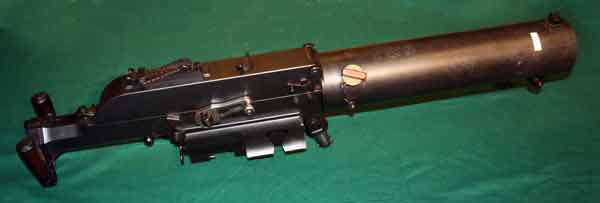 |
Medium
water cooled (Austrian M07/12 Schwarzlose) |
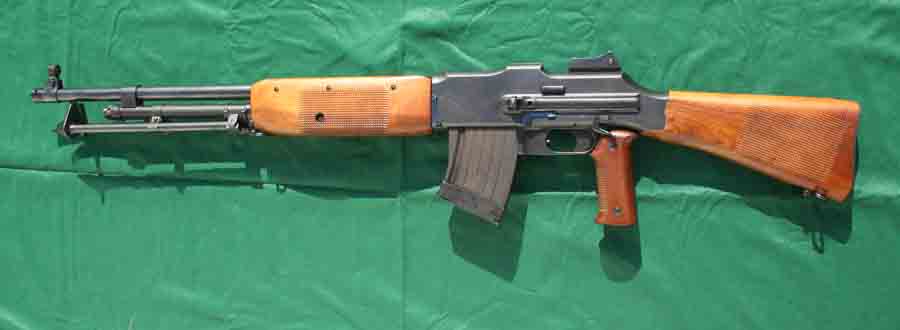 |
|
LMG - Kg m/1921 |
Light machinegun made by Fabrique Nationale used by the Swedish.
Light machinegun made by Fabrique Nationale (FN BAR) |
 |
|
The top line of the plate in the upper right corner says (Picture from Carl Gustafs Stads Gun Factory Weapon Museum.): |
 |
|
Sweden had bought a small number of the FN BAR M1930 with fixed barrel 1930 from Fabrique Nationale and it was called Kg m/1930 in Sweden. |
Light machinegun Kg m/1935 (FN BAR type D) |
|
 |
|
|
LMG Kg m/35 The top lines of the plate in the upper right corner says: Picture from Carl Gustafs Stads Gun Factory Weapon Museum. |
 |
|
The major drawback on kg m/21 (and m/30) was the fixed barrel which burned out fast during full automatic fire. To change the barrel of a kg m/21 needed the help of a skilled gunsmith. Fabrique Nationale had solved the problem burned out barrels by making a gun with exchangeable barrels. These LMG are known as FN type D. Sweden bought a small number of these FN BAR type D and they were named Kg m/1935. |
|
Light machinegun Kg m/1937 (BAR) |
|
|
|
LMG - Kg m/1937 |
|
1935 the Carl Gustaf Gun Factory came with a clever solution to the problem with replaceable barrels. Instead of twisting the barrel, a lock was added to the front part of the frame. The barrel is brought into position without twisting and parts of the lock on the frame twist into groves of the barrel instead. This modification was tried successfully as fm/1935 (Trial Model /1935). |
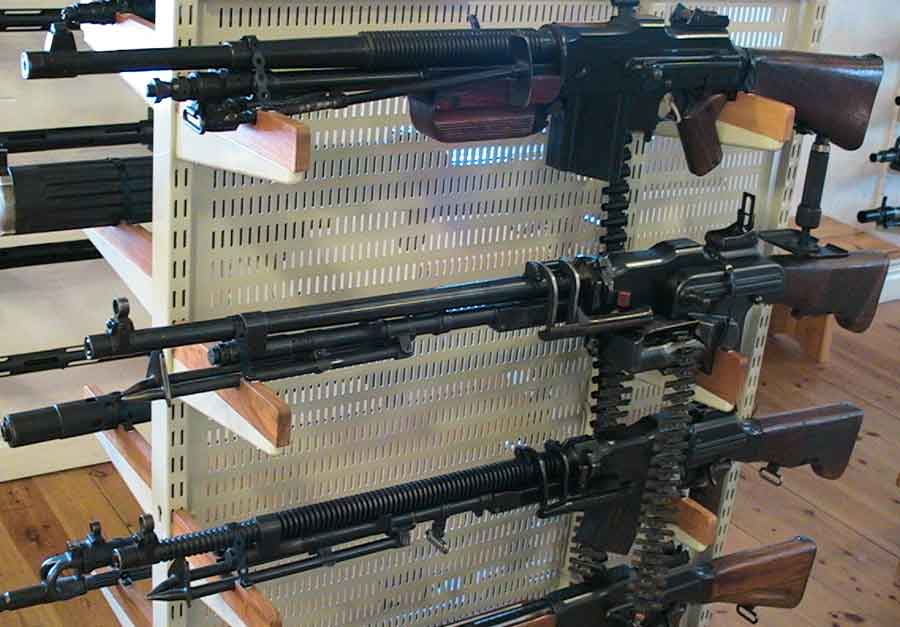 |
|
The LMG in the bottom of the rack (under the belt fed LMG) is Kg fm/35. The
barrel of Kg fm/35 had many
many cooling
flanges. Picture from Carl Gustafs Stads Gun Factory Weapon Museum. |
|
The flanges on the barrel of Kg fm/35 were removed on the accepted model Kg m/37. With this modification the LMG was accepted 1937 as kg m/37. |
Kg m/37 - The main support weapon of the Swedish army.
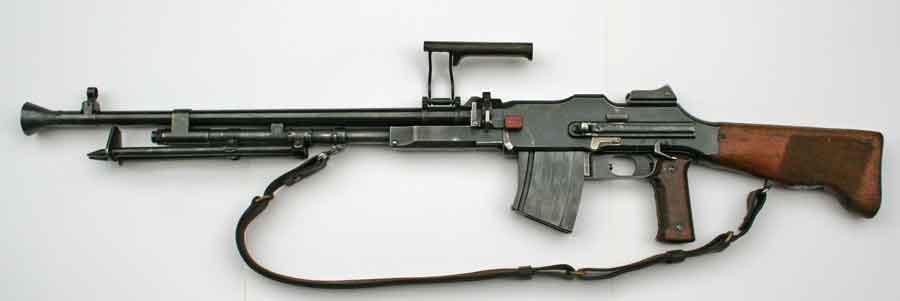 |
|
LMG - Kg m/1937 |
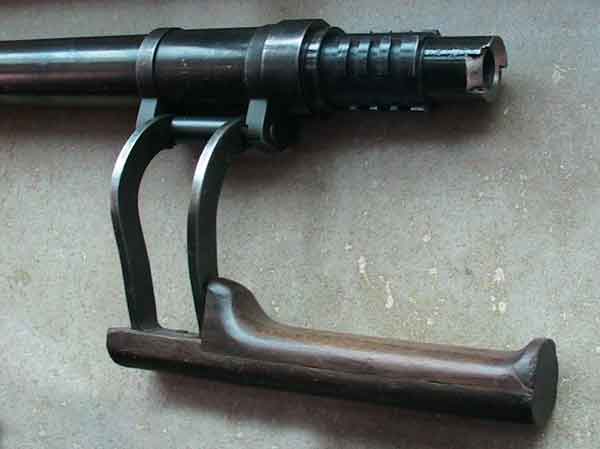 |
The barrel will remain without twisting |
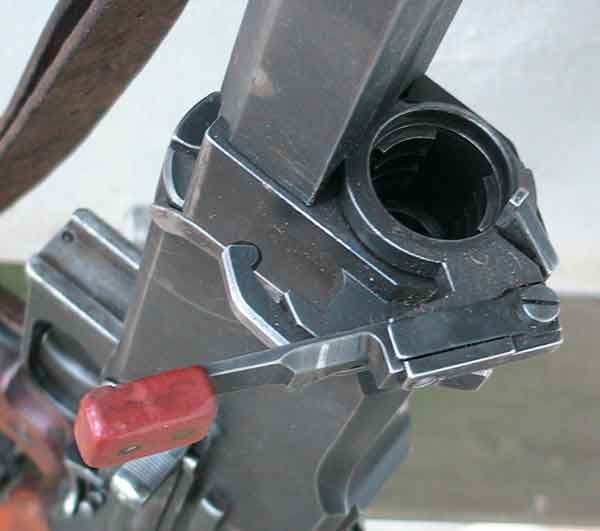 |
The lock in open position
|
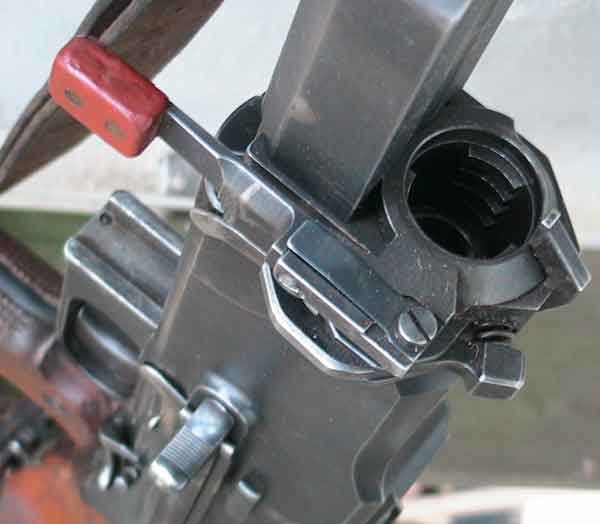 |
The lock in closed twisted position
|
|
The Kg m/37 became the main support weapon of the Swedish army together with the water cooled MG ksp m/1936. Still it is a construction which is rather expensive to produce. The machines from kg m/21 were still used. The gun has a gas regulator under the barrel which is adjusted dependant upon the ammunition used. It works very well with all types of ammunition even blanks. In this case the gun was equipped with a special blank firing device which trapped and crushed the wooden bullets. The cyclic rate for live ammunition can be made as slow as 500 rpm which makes it very easy to shoot with even during full automatic fire. Normally it was used to shoot short bursts or for single fire. Although it fires from an open bolt it is rather easy to hit with - even with single shots. Each kg m/37 was issued with one barrel, a leather sling and two boxes from leather with equipment and spare parts. Each kg m/37 came with 8 magazines which were kept in pairs in 4 leather pouches. A blank firing device could be screwed on to the barrel when the flash hider was removed. |
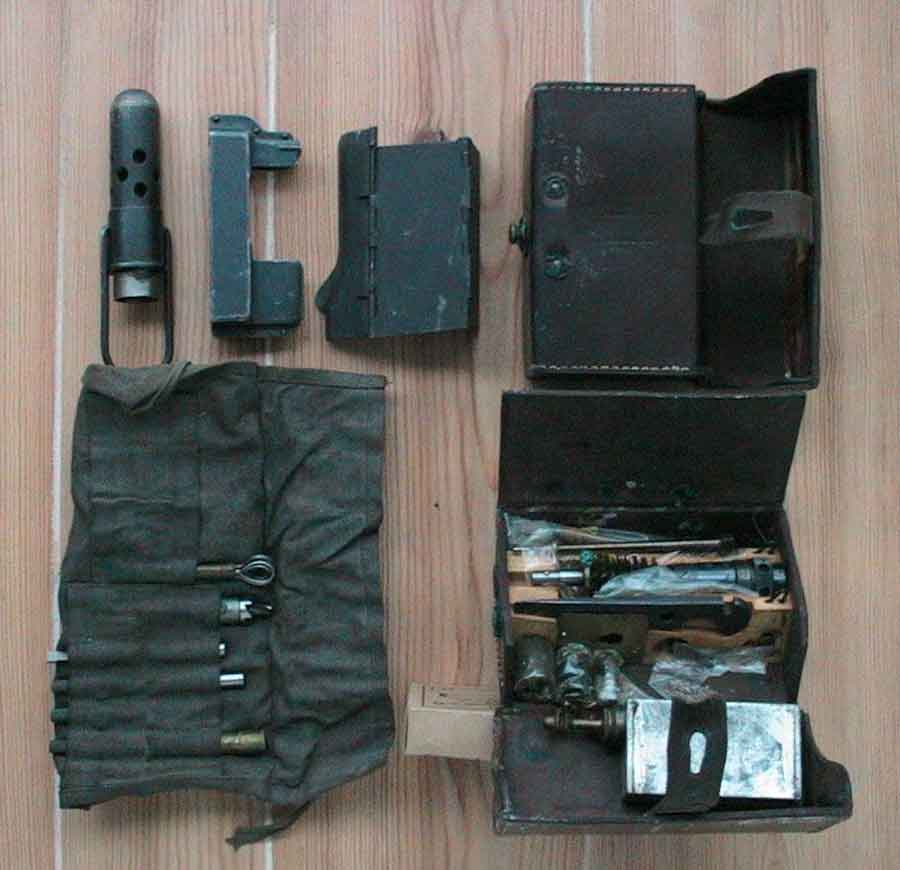 |
|
Equipment bags for Kg m/37 bag No 1 and No 2 and top to the left a blank firing device |
Box No 1 (spare parts and tools) contains: |
Box No 2 (spare parts and tools) contains: |
| Drill 2,87 mm with handle. Gas regulator S Shell extractor Universal tool Cleaning tool from brass Oil can Chamber tool Firing pin Extractor Extractor spring Handle for tool
|
Dust cover Rod Tool for loading ammo with clips. Pouch made by cloth Drill 1,15 mm with handle Drill 1,25 mm with handle Drill 1,35 mm with handle Drill with grinder Pin for hammer Pin for the link Brush Cleaning pins in a container Pin with spear point Pin blunt Drawing needle Drills in a container Drill 1,15 mm Drill 1,25 mm Drill 1,35 mm Ejection spring |
|
Magazines were kept in pairs in leather pouches. |
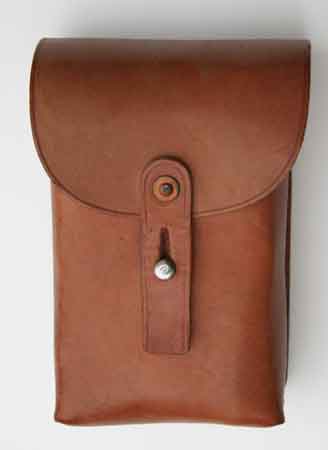 |
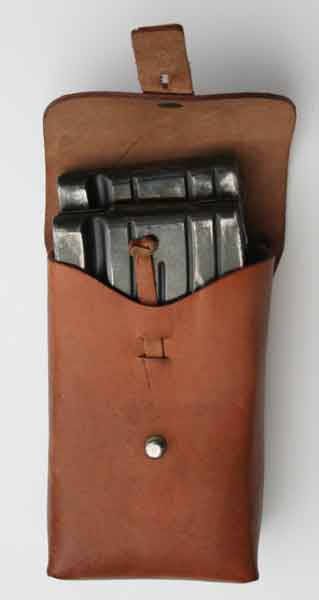 |
Specifications for BAR 1918, kg m/21 and kg m/37:
| BAR 1918 | Kg m/21 | Kg m/37 | |
| Calibre | 30-06 (7,62x63mm) | 6,5x55 mm | 6,5x55 mm |
| System | Gas | Gas | Gas |
| Length Total | 1194 mm | 1110 mm | 1110 mm |
| Length barrel | 610 mm | 670 mm | 670 mm |
| Weight MT | 7,3 kg | 8,7 kg | 8,9 kg |
| Magazine | 20 shot doubel-stack removable | 20 shot doubel-stack removable | 20 shot doubel-stack removable |
| Velocity | 855 m/s | 750 m/s | 750 m/s |
| Cyclic rate | 550 shots/min. | 500 shots/min. | 500 shots/min. |
| Full auto | Yes | Yes | Yes |
| Semi auto | Yes | Yes | Yes |
|
Belt fed Light Machinegun m/1937. |
|
As stated above the Swedish army was quite satisfied with kg m/37 and tests were made to change it for belt feeding after 2nd WW. Carl Gustaf Stads Gun Factory managed with this. Trial tests were made with the belt feeding of this very reliable gun. The drawback of the construction was that when you
emptied the gun after shooting four loaded cartridges are fell down. If this
happens in snow or in thick vegetation the live ammo might be lost and cause
harm to children who might find them. Another important drawback of this system
is that the last shots in each link will never be fired because there are no
more cartridges to lift them. The later accepted FN machinegun ksp m/58 is basically the same construction but without this drawback. |
|
|
|
Belt fed Light Machinegun m/1937.
|
Light machine gun Kg m/1939 (BRNO ZB-26).
|
|
Just before the start of WW2 there was a lack of arms in Sweden. The army saw the war coming and hurried to buy a number of Light machine guns from Czechoslovakia. The choice was the famous Kulomet VZ/26 with the German 7.92 mm round. Sweden called it kg m/39. The designers were two Chechs brothers: Vaslav and Emanuel Holek. An Austrian engineer Marek and Polish engineer Podradsky took also part in the construction. The ZB-26 was one of the finest LMG ever developed. Because of the high quality of steel provided by the Skoda plant, spare barrels coul be easily exchanged after full automatic fire. Even red hot barrels of this steel could be dipped in cold water without damaging them. This quick system of changing the barrels was an important feature of this nice design, because after 60-100 full auto shots it was time to change the barrel. The British Government chose the same gun, which was licened by ZB. They called their gun Bren.
The Swedish LMG m/39 magazine is mounted on top of the gun and holds 20 rounds. The barrel of kg m/39, which has many cooling flanges and a flash guard, is easy and fast to change. The mechanism is a development of the BAR but the knee link system is missing. Instead the bolt is locked by being forced up against the ceiling of the receiver. Kg m/39 fires both semi and full auto. When the magazine is empty the bolt remains at the rear end. The gas cylinder is very long, all the way under the barrel. This feature led to a slow rate of fire which makes the gun easily controlled. The cyclic rate is 500 rpm. When Sweden
bought the Kg m/39 it was issued with the German calibre 7,92x57 mm.
|
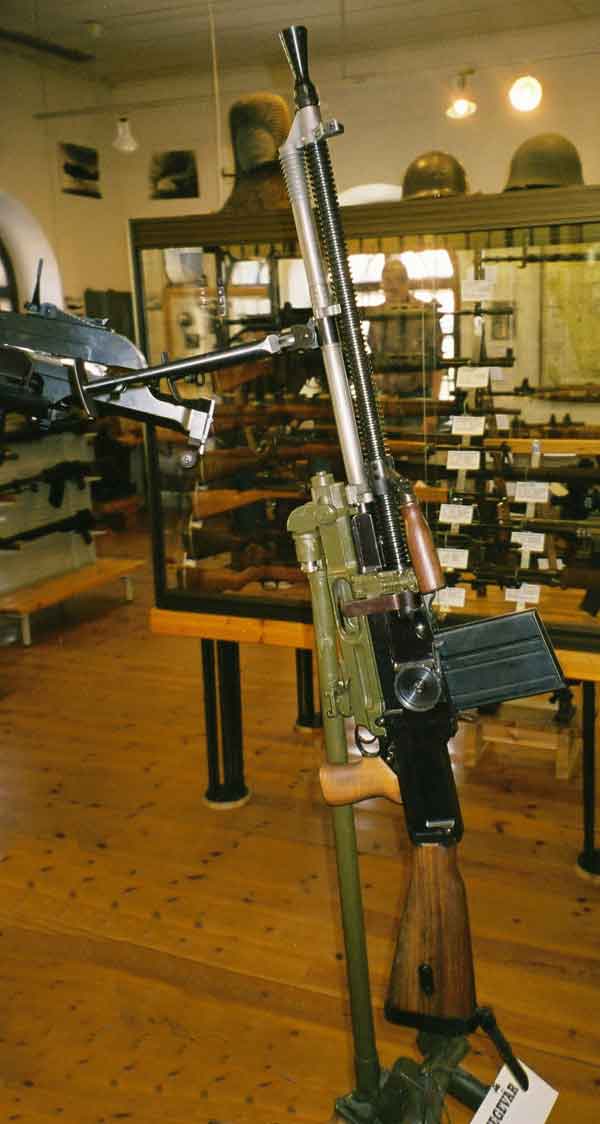 |
Kg m/39. Here on a tripod for air defence. Picture from Carl Gustafs Stads Gun Factory Weapon Museum.
|
|
|
Swedish Army instruction manual. There was not even time to make any ammunition for the 7,92x57 mm by the factories in Sweden. All such ammunition was imported to Sweden before the war.
|
|
|
|
|
Light machine gun Kg m/1940 (SAV).
|
|
1940 there was a desperate need for machineguns in Sweden. The production rate of kg m/37 was rather slow and not suitable for modern production. 1940 a LMG was accepted called system SAV (Svenska Automat Vapen = Swedish Automatic Weapons). The construction was German according to the famous writer and authority Josef Alm at the Swedish Army museum who was working there during and after the war. The name of this German was Lauf. The construction was further developed by a Swedish consortium. The mechanism works like the Swedish kg m/39 (BRNO LMG ZB26). When the bolt locks its rear end is pressed down to lock against the locking edge in the bottom of the receiver. Kg m/40 was produced by Svenska Automatvapen AB (SAV), though all parts were manufactured by various contractors in the Stockholm area. SAV was only responsible for the assemblage of the guns.
m/40 fires only full auto. It is possible to shoot single shoots likewise with the submachine gun m/45 by very fast releasing your finger from the trigger. The handle and the bipod are fixed to the gas-cylinder!
The m/40 magazine has a reinforcement across (see pictures) which is different from the m/37 magazine but they are interchangeable.
The m/40 soon became quite unpopular among the troops and it was quickly transfered to the Home Guard who didn't like it either and shortly after the war it was replaced by the twenty years older m/21.
A similar gun was made in Germany by the brake manufacturer Knorr-Bremse and used by the Waffen SS in limited numbers as the MG 35/36.
|
 |
| Top - trial model LMG Fm/1940
which became Bottom - the accepted LMG Kg/1940.
Note that both handle and bipod of Kg m/40 are fixed to the gas-cylinder! Picture from Carl Gustafs Stads Gun Factory Weapon Museum. |
 |
|
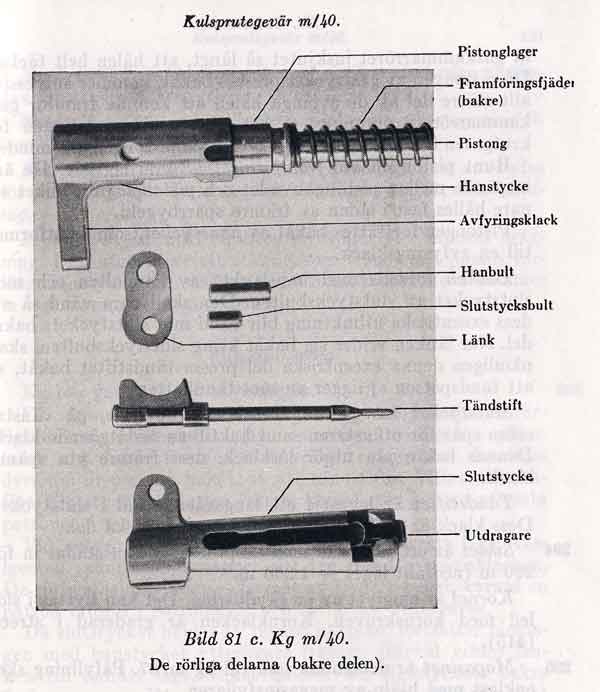 |
Pic. 81a Kg m/1940 (SAV) Pic. 81b
Pic. 81c
|
The Swedish BAR remained in service with the army until 1980.
|
The Swedish BAR - Kg m/37 was a very reliable and sound construction and was used in Swedish Army until 1980, when it was succeeded by FN light machinegun, Ksp m/58, was fully distributed.
The author used a kg /1937 as a
service weapon in the artillery 1971. The double mounted medium water cooled machine gun Ksp m/36 was used for air-defence. The Kg m/21 was replaced by Kg m/37 with the homeguard and remained in service until the beginning of 1990:s. |
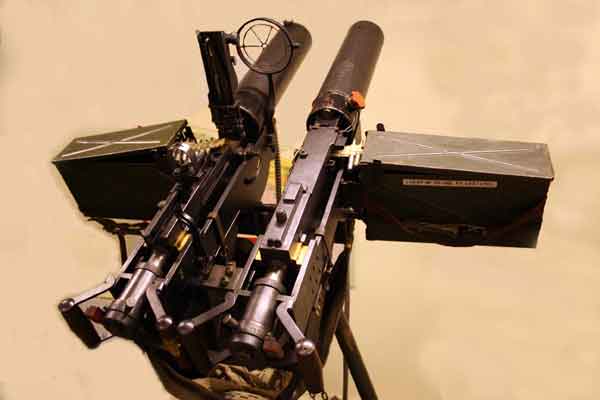 |
Double
mounted Medium water cooled
Machine
Gun
(MMG) Ksp m/1936 |
|
References:
Swedish Army: Instruction for the soldier of the
infantry 1943 |